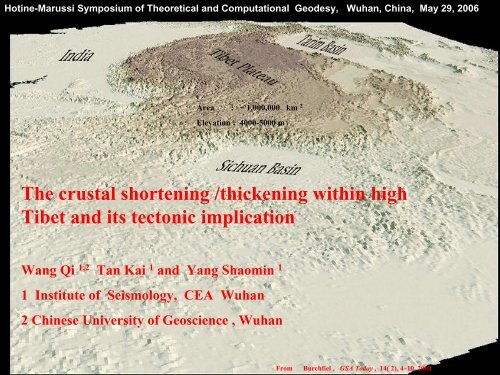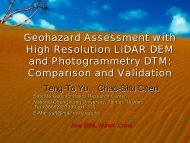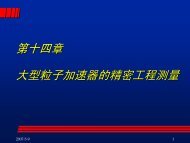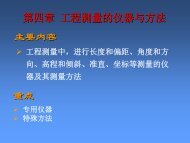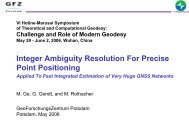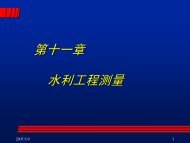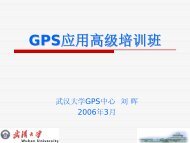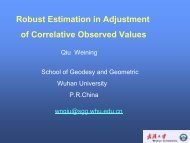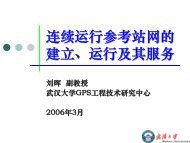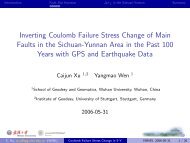The crustal shortening /thickening within high Tibet and its tectonic ...
The crustal shortening /thickening within high Tibet and its tectonic ...
The crustal shortening /thickening within high Tibet and its tectonic ...
- No tags were found...
Create successful ePaper yourself
Turn your PDF publications into a flip-book with our unique Google optimized e-Paper software.
Hotine-Marussi Symposium of <strong>The</strong>oretical <strong>and</strong> Computational Geodesy, Wuhan, China, May 29, 2006<br />
Area : ~ 1,000,000 km 2<br />
Elevation : 4000-5000 m<br />
<strong>The</strong> <strong>crustal</strong> <strong>shortening</strong> /<strong>thickening</strong> <strong>within</strong> <strong>high</strong><br />
<strong>Tibet</strong> <strong>and</strong> <strong>its</strong> <strong>tectonic</strong> implication<br />
Wang Qi 1,2 Tan Kai 1 <strong>and</strong> Yang Shaomin 1<br />
1 Institute of Seismology, CEA Wuhan<br />
2 Chinese University of Geoscience , Wuhan<br />
From Burchfiel , GSA Today , 14( 2), 4–10, 2004
<strong>Tibet</strong>an Plateau : Tectonic Setting<br />
1) India <strong>and</strong> Asia collide each other along<br />
Himalayas at 40-60 Ma<br />
2) Since then, India, subcontinent is moving<br />
northward at 40-55 mm/a<br />
3) <strong>Tibet</strong> is deforming in the Cenozoic era ,<br />
associated with various styles of <strong>tectonic</strong><br />
features in continent<br />
faulting, metamorphism, sedimentation,<br />
magmatism, earthquake, so on<br />
As summaried by Molnar & Tapponnier,<br />
Science,189, 419, 1975<br />
Features of recent continental <strong>tectonic</strong>s in Asia<br />
can be interpreted as results of the India-<br />
Eurasia collision.<br />
.<br />
Tapponnier et al., Science ,<br />
294,1671, 2001
Telling Feature : Raised <strong>Tibet</strong> with Striking Flatness<br />
South<br />
North<br />
<strong>Tibet</strong><br />
Seismic sounding profile<br />
India<br />
Vertical Stretching<br />
Horizontal N-S Shortening<br />
E-W Extending<br />
1 Crustal <strong>shortening</strong> is taking place<br />
in the direction of Indian northward<br />
movement path.<br />
2 Crust <strong>and</strong>/or upper mantle beneath <strong>Tibet</strong><br />
are thickened to double mean thickness of<br />
continental crust<br />
3 <strong>The</strong> <strong>Tibet</strong> is uplift, st<strong>and</strong>ing as the<br />
<strong>high</strong>est plateau in the world<br />
Question : How is the crust thickened <br />
Kind et al., Science, 298, 1219,2003
Uplift mode in <strong>Tibet</strong> I<br />
Subduction Model : Indian plate is underthrusting<br />
entirely into <strong>Tibet</strong>, proposed by Arg<strong>and</strong>, 1924<br />
1 <strong>The</strong> Indian plate plunged at<br />
Himalayas <strong>and</strong> extended<br />
northerly beneath the <strong>Tibet</strong>an<br />
crust<br />
North<br />
South<br />
2 <strong>Tibet</strong> is raised to the present<br />
topography progressively from<br />
south to north.<br />
Boosting in part, initiated in<br />
south <strong>and</strong> migrating to north<br />
Himalayas<br />
Tarim
Uplift mode in <strong>Tibet</strong> II<br />
Indentor ( Bulldoser ) Model : the crust is thickened by pure shear as with India<br />
indenting , proposed by Dewey & Bird , 1973<br />
Pre-collision<br />
South<br />
North<br />
Backstop<br />
Indentor<br />
Himalaya<br />
<strong>Tibet</strong> is raising steadily <strong>and</strong><br />
uniformly<br />
Tarim<br />
1 ) <strong>Tibet</strong> is deforming<br />
homogeneously<br />
throughout the lithosphere<br />
as viscous sheet<br />
Post-collision<br />
2) <strong>Tibet</strong> is uniformly<br />
raised to the present<br />
height
Uplift mode in <strong>Tibet</strong> III<br />
Injection “ Lift” Model: India lower crust is injecting<br />
into middle layer of <strong>Tibet</strong> crust , proposed by Zhao &<br />
Morgan 1987<br />
1 <strong>The</strong> India upper mantle<br />
is detached from overlying<br />
crust <strong>and</strong> sinking into<br />
asthenosphere<br />
North<br />
South<br />
2 <strong>The</strong> Indian crust is<br />
injecting into weak layer<br />
of <strong>Tibet</strong> crust <strong>and</strong><br />
weakening with reheating<br />
Upper crust is lifted<br />
up step by step<br />
Injecting, then<br />
steadily heating<br />
3 <strong>Tibet</strong> on wholesale is<br />
lifted hydrostatically <strong>and</strong><br />
reach ultimately to the<br />
maximum elevation<br />
Himalayas<br />
the weakened crust is<br />
flowing horizontally in the<br />
channel
Approaches for Model Constraint<br />
1 <strong>The</strong>se models are originally proposed to<br />
interpret features observed geologically <strong>and</strong><br />
geophysically<br />
Wang et al. Science, 249, 574 2001<br />
2 No single approach alone(geology , seismology,<br />
geomagnetism, palaeontology …) could yield all<br />
insights into the fundamental problem<br />
3 Geodesy can provide very useful constraints<br />
on present-day <strong>crustal</strong> deformation.<br />
4 GPS inferred velocity field is leading to better<br />
underst<strong>and</strong>ing of kinematics of <strong>tectonic</strong>s <strong>and</strong><br />
ultimately geodynamics of continental lithosphere.<br />
Zhang et al., Geology,32, 809, 2004
Kinematic Description of Asian Tectonics :<br />
Rigid block motion vs Viscous continuous deformation<br />
Molnar et al., Science 286, 516, 1999<br />
A<br />
B<br />
Royden et al., Science, 276, 788, 1997.<br />
Avouac & Tapponnier, Geophys Res Lett, 20, 895, 1993<br />
Royden et al., Science, 276, 788, 1997.
Velocity Pattern for rigid blocks :<br />
1 Localized deformation on weaken <strong>crustal</strong> zone<br />
2 Velocity leap in narrow belt by slip on active fault<br />
3 Stepwise velocity curve<br />
San Andreas<br />
GPS profile<br />
Deformation across the San Andreas fault,<br />
California, Prescott et al., JGR, 106, 6673, 2001<br />
GPS across Basin <strong>and</strong> Range Province, North<br />
America Thatcher Int Geol Rev, 45, 191, 2003.
Velocity Pattern for Viscous medium<br />
1 Distributed deformation throughout crust<br />
2 Velocity changes little across active fault<br />
3 Smooth velocity curve, decrease monotonically or<br />
linearly with respect to fixed point<br />
Visco-elastic Medium<br />
Driving Force<br />
Velocity<br />
fault<br />
Fixed point<br />
O<br />
Length<br />
Continuously<br />
Deforming<br />
Extension<br />
GPS Profile across boundary zone between the<br />
Australian <strong>and</strong> Pacific Plate, New Zeal<strong>and</strong>,<br />
Bourne et al, Nature, 391, 655,1998
GPS across <strong>Tibet</strong>an Plateau<br />
Conclusion I :<br />
In general, Conclusion GPS across I :<br />
<strong>Tibet</strong> shows a linearly<br />
In general, GPS across<br />
decreased velocity rates<br />
<strong>Tibet</strong> shows a linearly<br />
respect to Siberia from<br />
decreased velocity rates<br />
40 mm/yr to zero<br />
respect to Siberia from<br />
40 mm/yr to zero<br />
Wang et al. Science, 249, 574, 2001<br />
Conclusion II :<br />
Faults in <strong>Tibet</strong> slip at rates no more than 10 mm/yr except Himalayas,<br />
Perhaps the deformation is continuous <strong>and</strong> homogeneous<br />
Zhang et al., Geology,32, 809, 2004<br />
Problem : Sparse dataset does not rule out<br />
the discontinuous mode
~ 2000 site velocities from 1991 to 2004,
GPS Profile across <strong>Tibet</strong><br />
mm/yr<br />
Zanbo<br />
Nujiang<br />
Jinsha<br />
1 Thrust Slip Rates<br />
Zangbo : 6.2 ±1.4 mm/yr<br />
Nujiang : 7.4 ± 1.0 mm/yr<br />
Jinsha : 8.4 ± 1.3 mm/yr<br />
N15°E component<br />
Lhasa<br />
Velocity Profile based on<br />
elastic dislocation model<br />
Qiangtang<br />
Songpang<br />
2 <strong>The</strong> stepwise velocity in<br />
N15°E component across<br />
the High <strong>Tibet</strong><br />
3 Intervening blocks (Lhasa,<br />
Qiangtang, Songpan )<br />
Zangbo<br />
Nujiang<br />
Jinsha<br />
deform less than 2-3 mm/yr<br />
Zhang et al., Geology,32, 809, 2004
Himalayan-<strong>Tibet</strong>an Orogen<br />
Suture <strong>and</strong> Tertiary Fault:<br />
underthrusting was dominating in the <strong>high</strong> <strong>Tibet</strong><br />
Tertiary Shortening 10-20 Ma<br />
Hacker et al. , Science ,<br />
287, 2463, 2000<br />
Jinsha (Fenghuo Shan<br />
Thrust)<br />
60 - 80 km<br />
Bangong Nujiang<br />
(Amdo-Gaze Thrust)<br />
~250 km<br />
Yarlung Zangbo (Gangdes<br />
Thrust )<br />
> 60 km<br />
Tapponnier et al., Science ,<br />
294, 1671, 2001<br />
Fenghuo<br />
Shan Thrust<br />
Amdo-Gaze Thrust<br />
Gangdes Thrust,<br />
Yin et al., Annu Rev Earth Sci. 28,<br />
211,2 000.
Fault Plane Solution of Earthquake :<br />
No reverse fault in the<br />
interior of <strong>Tibet</strong> is identified<br />
Molnar & Lyon-Caen ,<br />
Geophys. J. int. , 99, 123, 1989<br />
From Chen et al., J.Geophys.Res. 109, 2002JB002151, 2004<br />
Quaternary Faults in <strong>Tibet</strong><br />
Yin et al., Annu Rev Earth Sci. 28, 211,2 000.<br />
No thrusting events M>6 in the<br />
interior of <strong>Tibet</strong> was recorded<br />
美 国 地 质 调 查 局<br />
Normal <strong>and</strong> striking-slip<br />
faulting is prevailing at<br />
present
Discussion<br />
• Have these thrusting structures be active since the collision or be<br />
reactivated during late Quaternary (100 kyr) , (10 kyr) Holocene ,<br />
even recent several years <br />
• <strong>The</strong> thrusting events may occur on the blind reverse faults, producing<br />
no rupture on surface instead of folding growth smeared by<br />
unroofing erosion.<br />
• Thrusting earthquake overcome harder friction on the larger interface<br />
than striking-slip events, thus requires long repeat time <strong>and</strong><br />
corresponding large earthquake<br />
• Localized elastic strain is absorbed by aseismic slip-event <br />
Tapponnier et al., Science ,294, 1671, 2001
Summary<br />
• New GPS show a pattern of discontinuous deformation from south to<br />
north across <strong>Tibet</strong>.<br />
• <strong>The</strong> thrusting slip rates on Gangdes, Banggong-Nujiang <strong>and</strong> Jinsha<br />
Suture are 6-8 mm/yr<br />
• Intra-<strong>crustal</strong> subduction along the sutures has thickened the uppermiddle<br />
crust under <strong>Tibet</strong>.<br />
• This is facilitated by continuous insertion of the Indian lower crust into the<br />
<strong>Tibet</strong>an lower curst, raising <strong>Tibet</strong>
Conceptional Model Modified after DeCelles et al, Tectonics, 21, 1062, 2002<br />
A variant of subduction model propsed<br />
by Arg<strong>and</strong> 1924<br />
Elevation History :<br />
Northerly migrating the 4000-meter front of <strong>Tibet</strong>an plateau,<br />
constrained by isotope-based palaeo-altimetry<br />
Rowley & Currie, Nature, 439,677 2006
Hotine-Marussi Symposium of <strong>The</strong>oretical <strong>and</strong> Computational Geodesy, Wuhan, China, May 29, 2006<br />
Area : ~ 1,000,000 km 2<br />
Elevation : 4000-5000 m<br />
<strong>The</strong> <strong>crustal</strong> <strong>shortening</strong> /<strong>thickening</strong> <strong>within</strong> <strong>high</strong> <strong>Tibet</strong> <strong>and</strong> <strong>its</strong> <strong>tectonic</strong> implication<br />
Thank your attention<br />
Wang Qi 1,2 Tan Kai 1 <strong>and</strong> Yang Shaomin 1<br />
1 Institute of Seismology, CEA Wuhan<br />
2 Chinese University of Geoscience , Wuhan<br />
From Burchfiel , GSA Today , 14( 2), 4–10, 2004


